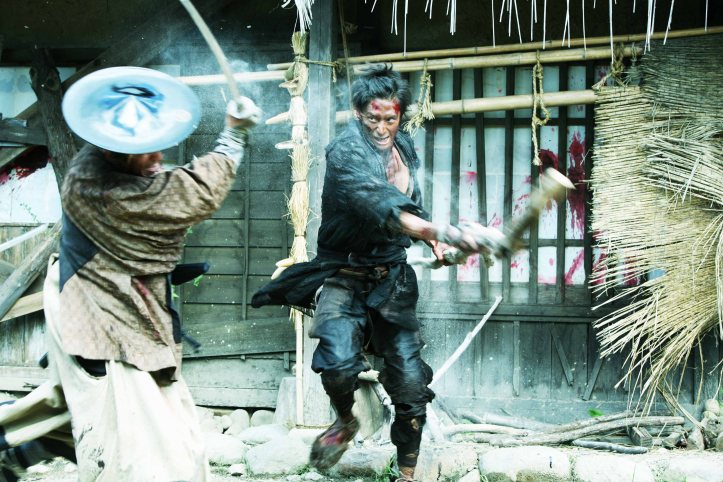The few who have disparaged Takashi Miike’s 13 Assassins often do so by comparing it unfavorably to Akira Kurosawa’s Seven Samurai. This is a criticism that I have always found unfair. Seven Samurai was a landmark of cinema, looking to tell a story about the isolation and obsolescence of the warrior class during times of peace. It shined a light on the tenuous relationship between soldier and civilian; the former just as likely to rob and rape the innocent as any bandit or invader. With the film released in 1954, almost a decade after VJ Day and the demilitarization of Japan, this movie also reassured a declawed nation that military was not the sole definer of national strength (manufacturing helps).

13 Assassins wanted to be an action movie, and there is nothing wrong with that, especially when it is a phenomenal one. Sure, it touches of themes about the death of warrior culture, with the samurai brought in as a last resort after diplomatic traditions (both civil and suicidal) failed. Despite their skill and effectiveness, they are a relic of a passing era. It also shows the viewer how autocratic ruling by divine lineage is a flawed political system that leads to human rights violations and dead bodies. Not exactly a barnburner revelation, but it was the structure for a competently assembled conflict and provided context for amazing fight scenes.
One thing you need to know, or may already know, about Takashi Miike is that he does not shy away from bloodshed. This man is infamous for his gruesomeness and surrealism in movies like Ichi the Killer and Dead or Alive. This ultra-violent, ultra-niche oddball has earned a strong cult appeal among geeks and purveyors of alternative cinema. While 13 Assassins may be one of his more “conventional” works, Takashi Miike can still feel like an acquired taste. Understand this as you read the rest of the review.

An elder lord commits seppuku to protest the actions of the shogun’s cruel half-brother, a young man named Matsudaira Naritsugu. DO NOT pass over the word “cruel” lightly. Carve that word into your mind with a rusty spoon, because you cannot imagine it until you see it. This guy is pure evil. Matsudaira is the kind of killer who makes Negan pee his pants, the kind of butcher who curdles Hannibal Lechter’s blood, and the kind of monster Joffrey Baratheon checks for in the dark corners of his room. The callous sadism Matsudaira demonstrates is almost uncanny in its extremes.
This brutality inspires an assassination plot in which the other lords ask a master samurai, Kaneko Shinzaemon, to assemble a team that can kill Matsudaira before he claims more power. This plan is a brought to a head after Shinzaemon learns what Matsudaira did to the daughter of a dissenting peasant leader. Now, it has become pretty pedestrian to use violence (particularly sexual violence) against women to justify manly vengeance stories. It’s a lazy and stunningly tacky narrative device, which communicates how misogynistic attacks are an affront to his honor rather than a disregard for her humanity.

With that said, the scene was effective. It make revile in horror when I saw what happened to her. Seriously, it is a gut punch that will linger in your mind days after the movie finishes playing. Think of Lavinia from Titus Andronicus but gorier and considerably more gratuitous. I am not sure how to feel about Miike breaking through my jadedness toward cheap teases of paternalistic impulses. I prefer not to be manipulated when watching movies, but it did inspire a reaction from me. I call it gross, but others may disagree, and that’s really up to them.
And if the viewer can move on from there they get what is essentially a 45 minute action sequence, and it is glorious. A serious of plot progressions result in a showdown between 200 mercenaries led by a sadistic warlord and the 12 samurai joined by a mysterious hunter. What keeps this fight from being a hilarious 15-second massacre is a series of elaborate traps the samurai have rigged up in an abandoned town: everything from barbed fences to explosives. The samurai have the tactical genius and situational awareness necessary to make this hopeless task and even fight.

With the mercenaries scattered and shaken, the elaborate and masterfully coordinated sword fighting sequences the unparalleled skill of the ronin. The choreography on display is something to marvel at. The battle becomes even more captivating because of impact it has on the samurai heroes. Even with action movie propensities toward supernatural endurance, the fight is ponderous for the ronin. The masters get cut and still keep fighting, but the viewer constantly wonders if this next blow will be the last one they can take.
The characteristically Japanese melodrama complements the suspense by loading the performances with powerful affective tension. 13 Assassins is not a dialogue heavy movie, and so every emotion is shown clearly on the faces of the samurai. The expressiveness of the heroes lends sentimental weight to the conflict and creates a level of investment in what is an otherwise utilitarian narrative. We feel for the characters because their emotions are so poignantly on display.

13 Assassins can be tough to get through. Although light on many of the trademark Takashi Miike qualities, there is still enough it here to make any unsuspecting viewer shy away. I personally would not blame anyone for switching this movie off after seeing what happened to the peasant leader’s daughter. It’s supposed to be disturbing, and deriding anyone for being disturbed is selfish and stupid. Despite that, if you have the stomach for some physiologically and philosophically offensive stuff, there is an unmatched action sequence at the end of this movie topped off by stellar acting performances. This is some fine action.
★★★★☆

Leave a comment